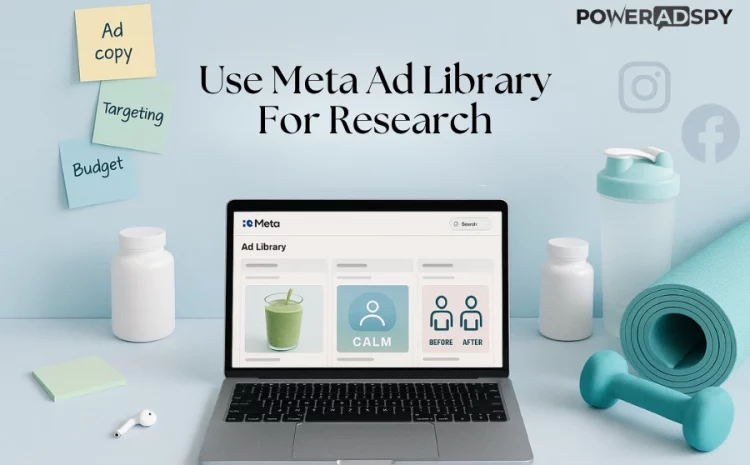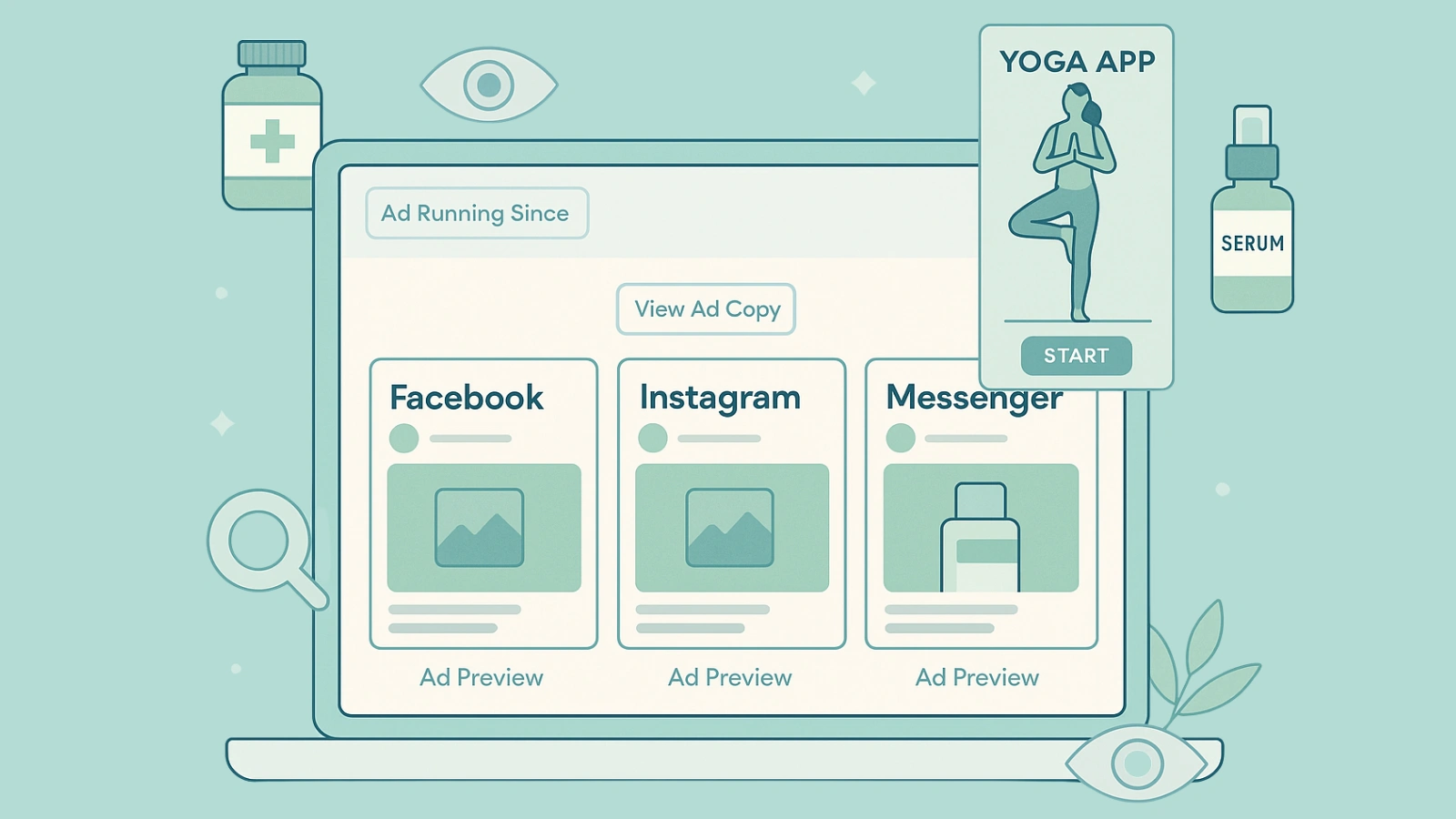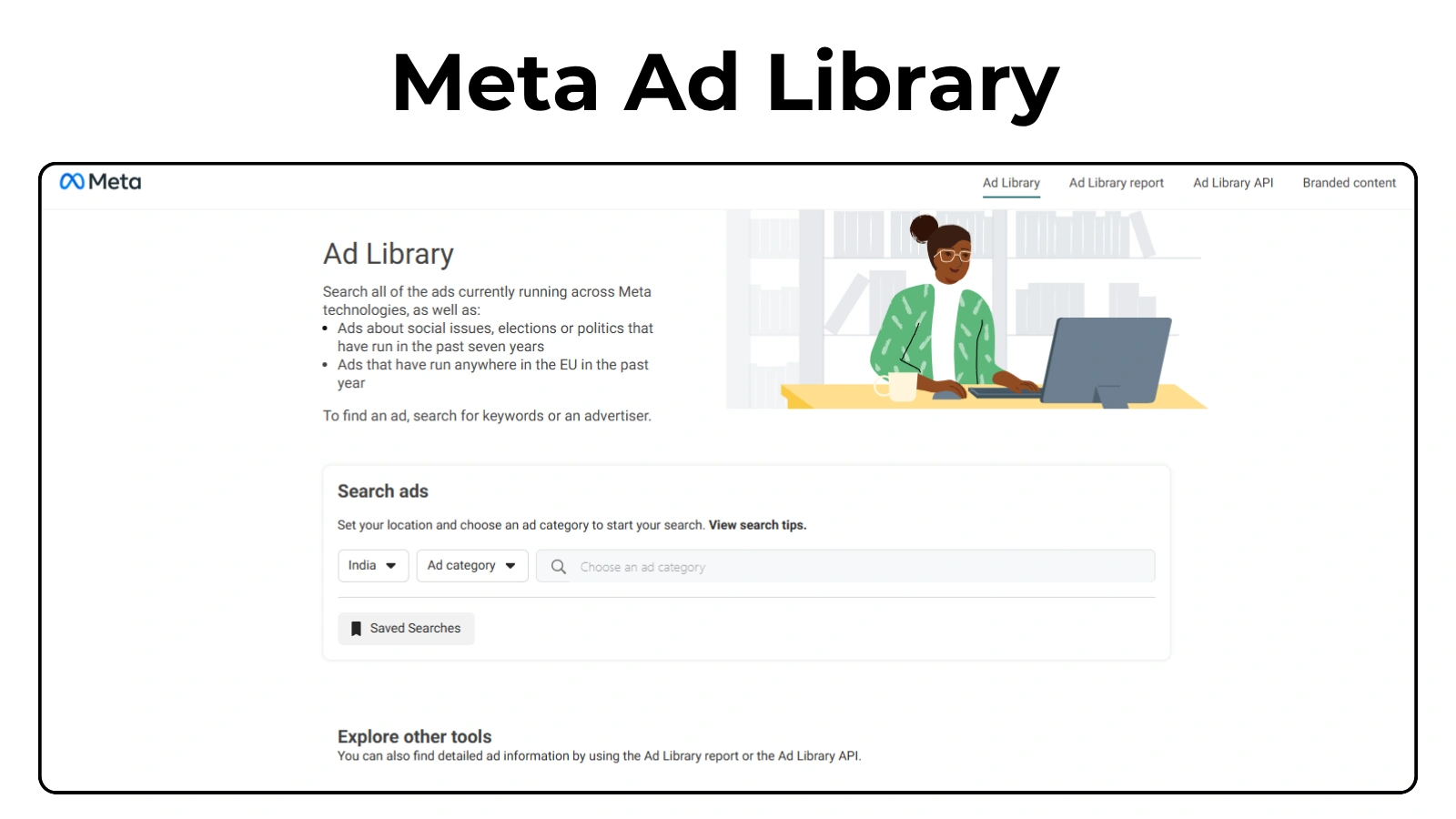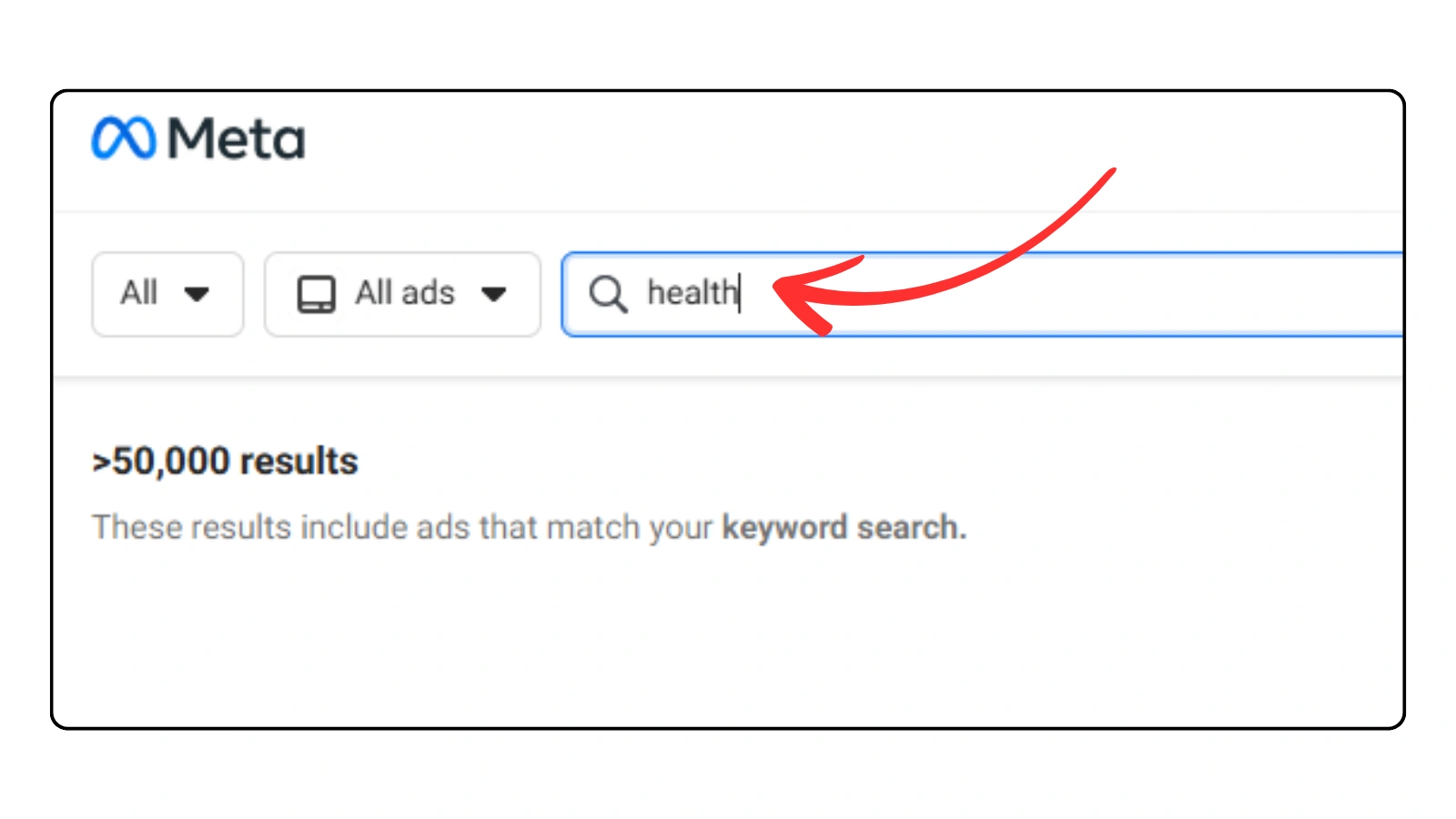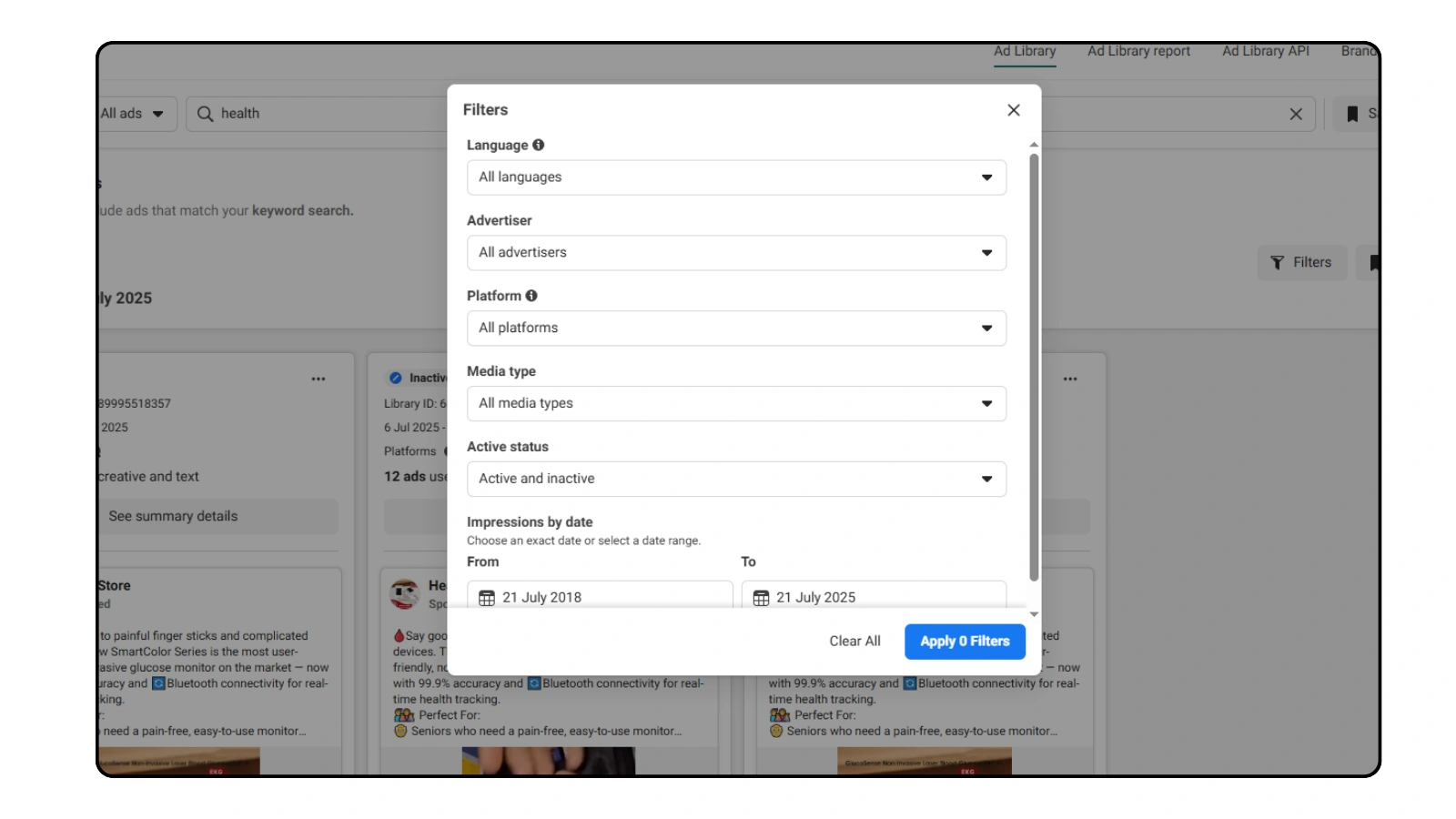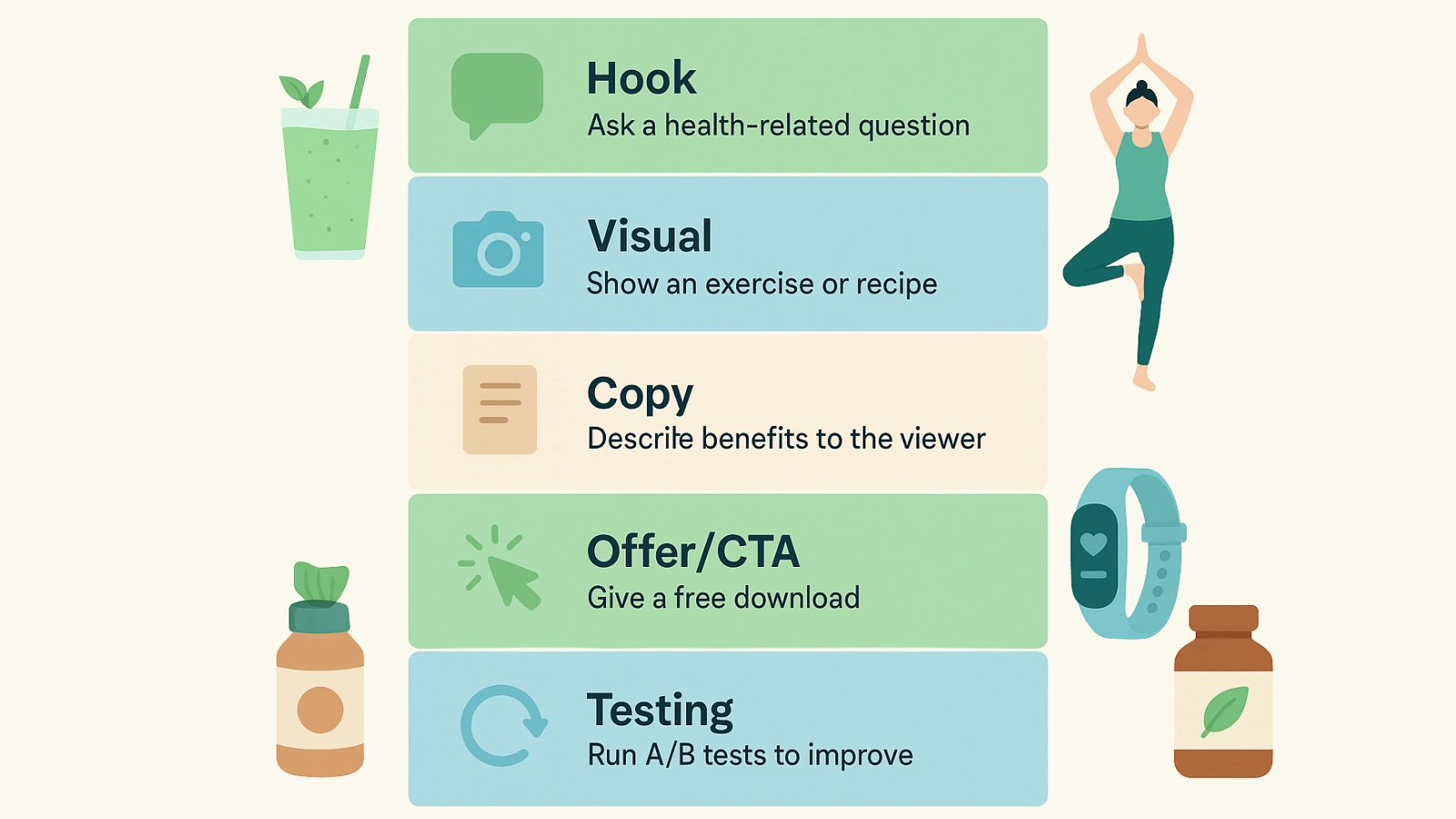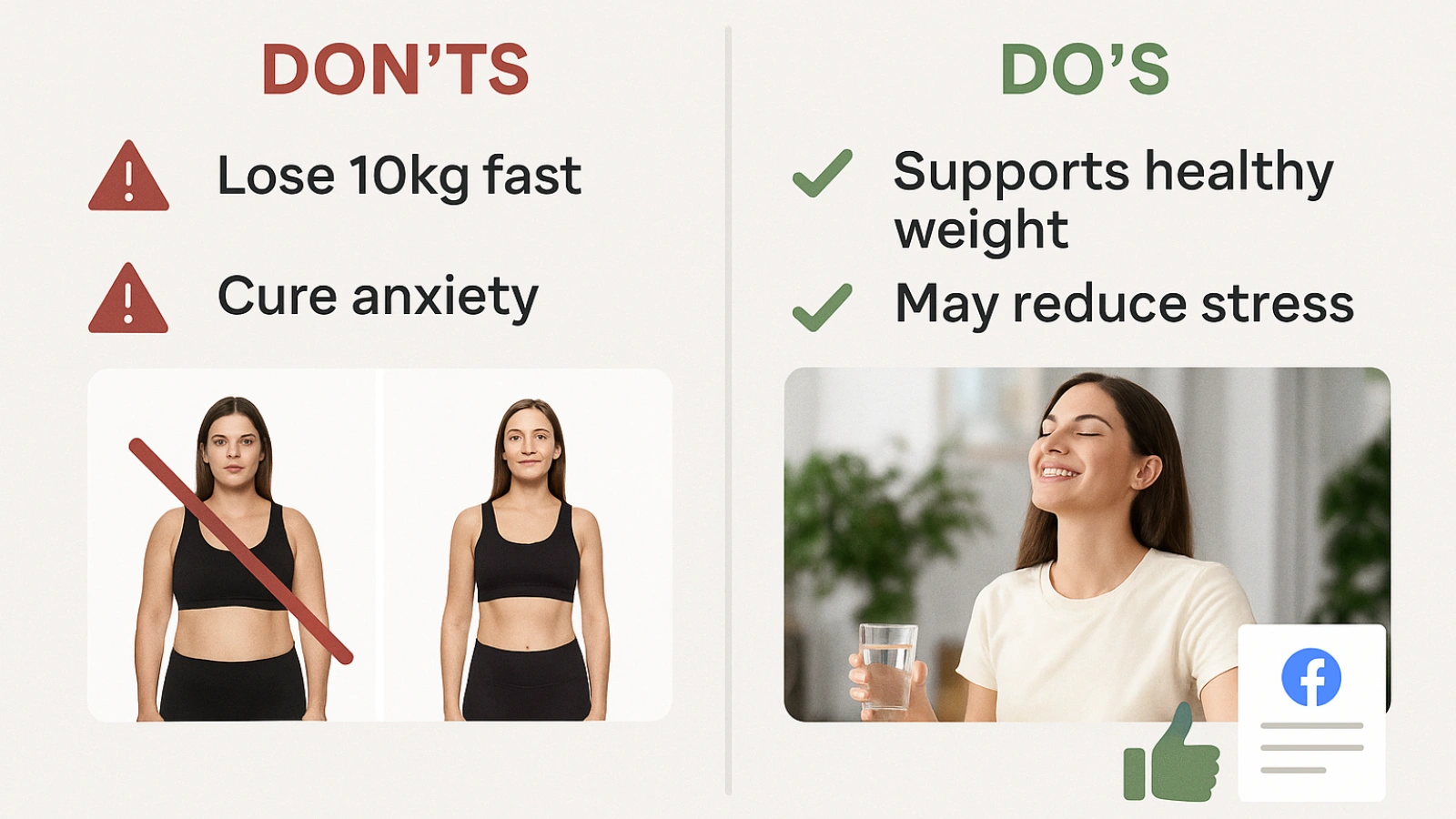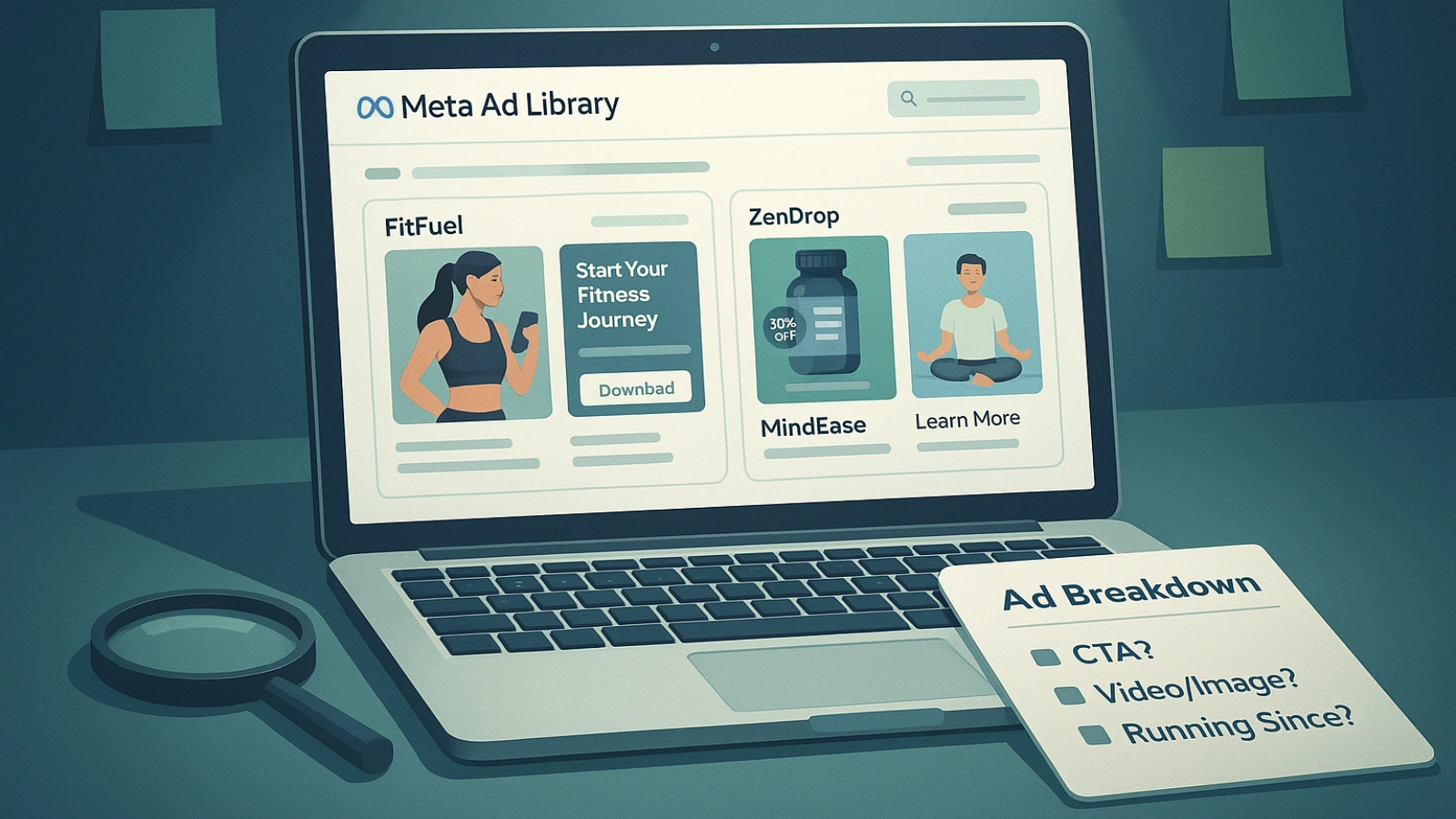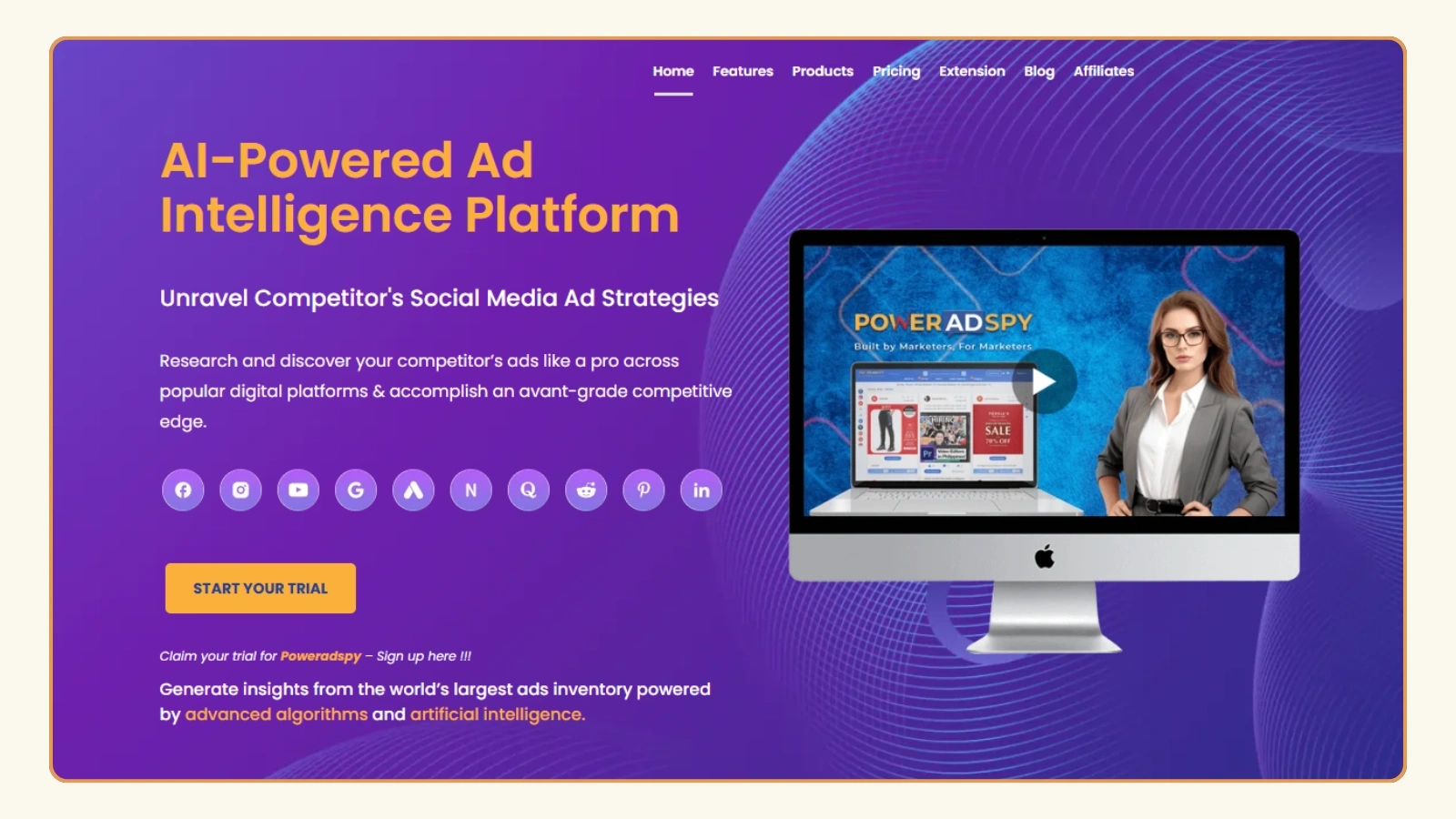How To Use Meta Ad Library For Health & Wellness Ad Research?
If you are running a health or wellness brand (such as fitness programs, supplements, or anything in between), you are already aware of the crowded market. Ads are everywhere. Everyone is trying to sell something. And most of it? Kinda looks the same.
It’s becoming increasingly difficult to stand out.
Ads cost more.
And Meta (also known as Facebook Ads and Instagram Ads) has a multitude of rules, particularly for health-related content.
That is why the Meta Ad Library is so useful. It is a free tool that lets you see exactly what ads other brands are running, how long they have been running, what their message looks like, and even how often they change things up.
In this blog, we will walk you through:
- How to find good ad ideas in the health and wellness space
- What to watch out for so your ads don’t get banned
- How to learn from other brands (without copying)
- How to turn your research into better ads that get results
If you are trying to grow your health brand in 2025 and you are not using the Meta Ad Library… you are seriously missing out.
Let’s change that.
In a hurry? Listen to the blog instead!
What Is The Meta Ad Library (And Why Should Health Brands Care)?
So, before we go full research mode, let’s clear this up:
The Meta Ad Library (sometimes called the Facebook Ads Library) is a public tool that shows all the ads currently running across Facebook, Instagram, Messenger, and even the Meta Audience Network.
It was made to keep things transparent, basically so people can see who is running ads and what they are saying. But for marketers? It’s a goldmine.
Here’s why it matters for you:
You Can See What Your Competitors Are Doing
Ever wonder how those supplement brands are crushing it? Or how fitness coaches are getting so many leads? Meta Ad Library lets you peek behind the curtain and see their actual ads, images, videos, copy, CTA, everything.
You Learn What Is Working.
If a brand is running the same ad for months, chances are it is making money. The library shows you how long an ad has been live, which helps you figure out what’s probably working and what’s just being tested.
You Avoid Breaking Meta’s Rules
Health & wellness ads get flagged all the time. If you don’t want your account banned, it’s smart to look at how others are safely promoting things like weight loss, skincare, or mental health services.
So, it is not just some random tool. It is a major shortcut for building smarter and more effective ad campaigns, especially in a tricky niche like health and wellness.
How To Use Meta Ad Library Search For Health & Wellness Ad Research?
The Meta Ad Library can look kind of boring at first, but once you know how to search correctly, it gets super helpful. Here is how to get the most out of it when you are researching ads for your health brand.
Step 1: Go to the Site
Just Google “Meta Ad Library” or go to No login needed. You’re in.
Step 2: Pick Your Country
Start by selecting the country you want to see ads from. If you are selling worldwide, stick with the U.S. or your main market.
Step 3: Use the Search Bar
Now type in a keyword, brand name, or product type.
Here are some good searches for health & wellness:
- “gut health”
- “fitness coach”
- “hair growth supplements”
- “mental wellness app”
- “[insert competitor name]” (ex, Organifi, Athletic Greens, Noom, etc.)
You will instantly see all the ads that match.
Step 4: Use the Filters
Once you search, click on the filters. You can sort by:
- Platform (Facebook, Instagram, Messenger)
- Media Type (image, video, carousel)
- Date range (when the ad started)
Pro tip: If an ad’s been running for months, it’s probably performing well.
Step 5: Take Notes Like a Pro
When you find an ad that looks good, don’t just say “cool” and move on. Ask yourself:
- What’s the hook or headline?
- Is the image super clean, or kind of raw and real?
- Is the ad focused on benefits, not features?
- Are there any disclaimers or medical language?
- What kind of CTA are they using? (“Buy now” vs “Take the quiz,” etc.)
Keep a swipe file (Google Doc or Notion page) and save anything that stands out.
Don’t Copy, Analyze
It’s tempting to just steal a good ad and tweak a few words. But don’t.
Meta’s pretty strict with health ads, so your goal is to understand what works, not rip it off.
Use the patterns to inspire your version that fits your brand voice and offer.
Also Read!
How To Use Meta Ad Library The Right Way In 2025?
What To Look For In Health & Wellness Ads Inside Meta Ad Library?
So now you have found a bunch of ads using Meta Ad Library. But what exactly should you be paying attention to?
This is where the real research starts.
The goal here is not just to see what others are doing; it is to spot patterns and pull inspiration so you can create better ads for your own health or wellness brand.
Here’s what to watch for:
1. The Hook (First Line That Grabs You)
The first few words of an ad are everything. You are looking for:
- Questions (Ex, “Struggling with bloating?”)
- Shocking stats (Ex, “80% of adults are low on magnesium”)
- Bold statements (Ex, “This isn’t your average protein shake”)
The hook sets the tone and gets people to stop scrolling. Keep a list of the best ones you see.
2. The Visuals (Image or Video)
Meta favours ads that get engagement, and visuals play a huge role.
Look at:
- Image type: Lifestyle pics, product flat lays, UGC-style selfies?
- Video ads: Testimonials, tutorials, animations?
- Vibe: Is it clinical and clean, or more natural and real?
In health, realness beats perfection. A selfie with an honest caption might beat a polished studio shot.
3. The Copy (The Message They Are Selling)
Read the whole thing, headline, description, and body text.
Ask yourself:
- Are they focusing on pain points or benefits?
- Are they making big health claims, or keeping it light and safe?
- Is it friendly and relatable, or more professional and scientific?
Also, notice if they include:
- Disclaimers
- “Before and after” claims
- Mentions of doctors or medical advice
Meta is strict about this stuff. If you see health ads running for months with clean copy, they are probably doing it right.
4. The Offer + CTA (Call to Action)
What is the actual goal of the ad?
- “Buy now” = they are going direct-to-sale
- “Take our quiz” = they’re qualifying leads
- “Download the app” = SaaS-style approach
- “Join the challenge” = community-based funnel
Match the CTA with the brand’s funnel strategy. It will give you clues for building your own.
5. Repeats, Variations & Testing
Some brands run slight variations of the same ad with different:
- Hooks
- Headlines
- CTAs
- Visuals
This means they are testing. Pay attention to which version sticks around the longest; that’s probably the winner.
Pro Tip: Make a swipe file organized by:
- Hooks
- Offers
- Visuals
- Copy style
It will save you tons of time when writing or designing your next campaign.
Understanding Meta’s Ad Policies For Health & Wellness Brands
If there is one thing you need to know about health ads on Facebook or Instagram, it’s this:
Meta does NOT play around.
They are super strict with anything related to:
- Weight loss
- Body image
- Medical claims
- Mental health
- Supplements or “natural” cures
So if you are running ads in the health & wellness area, you have got to stay within the rules, or your ads will get disapproved, your account could get flagged, or worse… banned.
Here is what you need to know:
1. Don’t Make Unrealistic or “Too Good to Be True” Claims
Examples of what not to say:
- “Lose 10kg in 2 weeks”
- “Cure your anxiety forever.”
- “This supplement fixes all your problems.”
Meta will shut that down fast.
Instead, go with words like:
- “Supports healthy weight”
- “May help reduce stress”
- “Formulated to boost energy naturally”
Keep it realistic, and always soft-sell the benefit.
2. Avoid Personal Attributes
Meta does not allow you to call people out based on health, age, weight, or appearance.
Don’t say:
- “Are you struggling with acne?”
- “Tired of feeling overweight?”
- “Do you feel depressed all the time?”
Do say:
- “This skincare routine is designed for clearer skin.”
- “A wellness plan built to support your health goals”
- “Tools that help manage stress, naturally”
You are describing the product, not the person.
3. Be Careful With Before/After Images
Meta hates them. Even if they are real, even if they are amazing, they are usually flagged.
If you want to show results:
- Use testimonials
- Show lifestyle transformation stories
- Highlight product use, not body changes
Keep it subtle. Trust builds better than shock value.
4. Always Include Disclaimers
If your product affects health in any way (supplement, diet, therapy, etc.), add a clear disclaimer in the ad or landing page like
“These statements have not been evaluated by the FDA. This product is not intended to diagnose, treat, cure, or prevent any disease.”
It shows Meta (and your audience) that you are playing by the rules.
5. Follow the Official Meta Policy Guidelines
If you want to go deeper, check out Meta’s Ad Policy Page. Look for these sections in particular:
- Prohibited content
- Personal health and appearance
- Supplements
- Misleading claims
Meta wants advertisers, especially in health, to be honest, ethical, and clear. If your ads feel scammy, aggressive, or too good to be true, they will get flagged.
And if you are not sure? Look at other health ads that have been running for 30+ days. That is your blueprint for what Meta allows.
How To Analyze Competitor Health Brands Using Meta Ad Library?
This is where you study your competitors to figure out what is working for them, then use those insights to create smarter ads for your brand.
Step 1: Search for Your Direct Competitors
Start by searching actual brand names in the Meta Ad Library. If you don’t know who to look for, try brands selling:
- Supplements (like Organifi, Bloom, JSHealth)
- Fitness programs (like FitBody App, MadFit)
- Mental wellness (like Calm, Headspace)
Pro tip: Search for brands targeting the same audience as you, even if they sell something different. If their ads are working, you can learn from their style, copy, and funnel strategy.
Step 2: Look at How They Structure Their Ads
When you are in a brand’s ad library, ask yourself:
- Do they use short or long copy?
- Is the ad video-heavy or image-based?
- Are they running ads with different styles for different offers?
- What kind of CTA are they using? (“Buy now,” “Take quiz,” “Learn more”)
- How often do they change up their creatives?
Try to figure out where they are taking people, direct sale, lead form, quiz funnel, free ebook, etc.
Step 3: Check Longevity
If you see the same ad running for months, that’s your signal: it’s working.
No brand pays to run an underperforming ad for 90 days straight.
These long-running ads are blueprints. Study their copy tone, structure, and design.
Go Deeper With PowerAdSpy
Meta Ad Library is great, but it has limits. It only shows active ads, and you can’t filter by engagement or performance.
That’s where PowerAdSpy comes in.
What Is PowerAdSpy?
PowerAdSpy is a powerful ad spy tool that gives you access to a massive library of ads from Facebook, Instagram, YouTube, Google, and more. Unlike Meta Ad Library, it also shows you:
- Engagement (likes, comments, shares)
- Landing pages are where the ads go
- Exact targeting filters
- Old/deactivated ads (not just live ones)
It’s Meta Ad Library on steroids.
Key Features of PowerAdSpy:
- Niche Search: Find ads by keywords like “gut health,” “weight loss,” or “natural energy.”
- Advanced Filters: Sort ads by country, platform, ad type, call to action, and more
- Ad Lifetime Tracking: See how long ads have been running (and which ones were paused)
- Landing Page View: Click through to see exactly where the ad leads
- Engagement Insights: Analyze likes, shares, and comments to see how people are reacting
- Ad Bookmarking: Save your favorite ads to your swipe file inside the platform
- Multi-Platform Access: Not just Facebook, also tracks ads from Instagram, YouTube, Google, and more
Final Thoughts
Running ads in the health & wellness area is not easy. You have got rules, competition, rising costs, and an audience that’s seen everything.
But here is the good news: you don’t have to guess anymore.
With tools like Meta Ad Library (for free research) and PowerAdSpy (for deeper insights), you have got everything you need to:
- Study what top brands are doing
- Stay 100% compliant with Meta’s policies
- Get ideas for hooks, offers, visuals, and copy
- Build ad campaigns that convert, without wasting money
Most brands skip the research and jump straight into launching ads. Don’t be like them.
Learn what works, then go build something better.
So, whether you are selling a supplement, launching a fitness app, or building your wellness brand from scratch, this is your sign to start using the Meta Ad Library today.
It’s free. It’s simple. And if you use it right?
It will level up your ad game like crazy.
FAQs About Using Meta Ad Library For Health & Wellness Brands
Can I use Meta Ad Library to research ads from Instagram only?
Yes, you can. When you are inside the Meta Ad Library, just use the filter option to select “Instagram” under platforms. This is super helpful if your brand is more focused on IG content.
Can I track how much my competitors are spending on ads?
Nope, Meta Ad Library does not show spend data. It only shows what ads are running, how long they have been active, and where they are showing.
But if you are looking for budget estimates, tools like PowerAdSpy can give rough ad spend ranges based on impression estimates and ad reach history.
Q3. How often is the Meta Ad Library updated?
Pretty often—usually daily. Meta does not give an exact schedule, but ads are generally added and removed from the library every 24 hours. So if a brand launches a new campaign today, there’s a good chance it’ll show up tomorrow.
Q4. Can I use Meta Ad Library to research ads from other industries, too?
100%. While this blog focuses on health & wellness, you can use Meta Ad Library to research any industry, e-commerce, SaaS, coaching, finance, or even politics.
The research method stays the same. Just tweak your keywords to match your niche.

